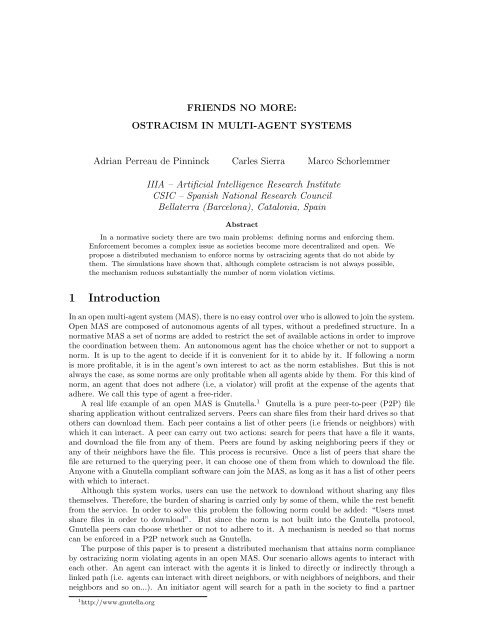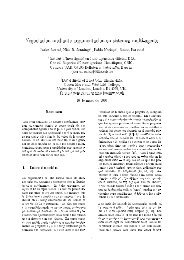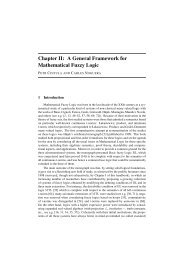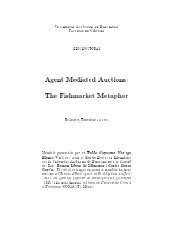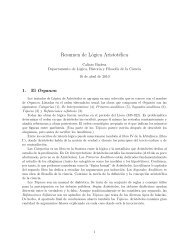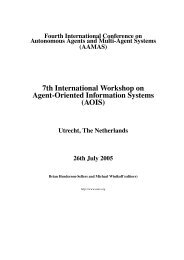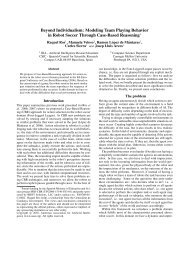Ostracism in Multi-Agent Systems - CEUR Workshop Proceedings
Ostracism in Multi-Agent Systems - CEUR Workshop Proceedings
Ostracism in Multi-Agent Systems - CEUR Workshop Proceedings
Create successful ePaper yourself
Turn your PDF publications into a flip-book with our unique Google optimized e-Paper software.
FRIENDS NO MORE:<br />
OSTRACISM IN MULTI-AGENT SYSTEMS<br />
Adrian Perreau de P<strong>in</strong>n<strong>in</strong>ck Carles Sierra Marco Schorlemmer<br />
IIIA – Artificial Intelligence Research Institute<br />
CSIC – Spanish National Research Council<br />
Bellaterra (Barcelona), Catalonia, Spa<strong>in</strong><br />
Abstract<br />
In a normative society there are two ma<strong>in</strong> problems: def<strong>in</strong><strong>in</strong>g norms and enforc<strong>in</strong>g them.<br />
Enforcement becomes a complex issue as societies become more decentralized and open. We<br />
propose a distributed mechanism to enforce norms by ostraciz<strong>in</strong>g agents that do not abide by<br />
them. The simulations have shown that, although complete ostracism is not always possible,<br />
the mechanism reduces substantially the number of norm violation victims.<br />
1 Introduction<br />
In an open multi-agent system (MAS), there is no easy control over who is allowed to jo<strong>in</strong> the system.<br />
Open MAS are composed of autonomous agents of all types, without a predef<strong>in</strong>ed structure. In a<br />
normative MAS a set of norms are added to restrict the set of available actions <strong>in</strong> order to improve<br />
the coord<strong>in</strong>ation between them. An autonomous agent has the choice whether or not to support a<br />
norm. It is up to the agent to decide if it is convenient for it to abide by it. If follow<strong>in</strong>g a norm<br />
is more profitable, it is <strong>in</strong> the agent’s own <strong>in</strong>terest to act as the norm establishes. But this is not<br />
always the case, as some norms are only profitable when all agents abide by them. For this k<strong>in</strong>d of<br />
norm, an agent that does not adhere (i.e, a violator) will profit at the expense of the agents that<br />
adhere. We call this type of agent a free-rider.<br />
A real life example of an open MAS is Gnutella. 1 Gnutella is a pure peer-to-peer (P2P) file<br />
shar<strong>in</strong>g application without centralized servers. Peers can share files from their hard drives so that<br />
others can download them. Each peer conta<strong>in</strong>s a list of other peers (i.e friends or neighbors) with<br />
which it can <strong>in</strong>teract. A peer can carry out two actions: search for peers that have a file it wants,<br />
and download the file from any of them. Peers are found by ask<strong>in</strong>g neighbor<strong>in</strong>g peers if they or<br />
any of their neighbors have the file. This process is recursive. Once a list of peers that share the<br />
file are returned to the query<strong>in</strong>g peer, it can choose one of them from which to download the file.<br />
Anyone with a Gnutella compliant software can jo<strong>in</strong> the MAS, as long as it has a list of other peers<br />
with which to <strong>in</strong>teract.<br />
Although this system works, users can use the network to download without shar<strong>in</strong>g any files<br />
themselves. Therefore, the burden of shar<strong>in</strong>g is carried only by some of them, while the rest benefit<br />
from the service. In order to solve this problem the follow<strong>in</strong>g norm could be added: “Users must<br />
share files <strong>in</strong> order to download”. But s<strong>in</strong>ce the norm is not built <strong>in</strong>to the Gnutella protocol,<br />
Gnutella peers can choose whether or not to adhere to it. A mechanism is needed so that norms<br />
can be enforced <strong>in</strong> a P2P network such as Gnutella.<br />
The purpose of this paper is to present a distributed mechanism that atta<strong>in</strong>s norm compliance<br />
by ostraciz<strong>in</strong>g norm violat<strong>in</strong>g agents <strong>in</strong> an open MAS. Our scenario allows agents to <strong>in</strong>teract with<br />
each other. An agent can <strong>in</strong>teract with the agents it is l<strong>in</strong>ked to directly or <strong>in</strong>directly through a<br />
l<strong>in</strong>ked path (i.e. agents can <strong>in</strong>teract with direct neighbors, or with neighbors of neighbors, and their<br />
neighbors and so on...). An <strong>in</strong>itiator agent will search for a path <strong>in</strong> the society to f<strong>in</strong>d a partner<br />
1 http://www.gnutella.org
agent with which to <strong>in</strong>teract. All the agents <strong>in</strong> the path that are not the <strong>in</strong>itiator or the partner<br />
agent will be called mediator agents (i.e, agents mediat<strong>in</strong>g the <strong>in</strong>teraction).<br />
We use a game-theoretic approach to <strong>in</strong>teractions. They are modeled as a two-player game<br />
with two possible strategies; cooperate and defect. The utility function will be that of a prisoner’s<br />
dilemma (see Figure 1), s<strong>in</strong>ce the total utility ga<strong>in</strong>ed by both players is maximized if both players<br />
cooperate, and the maximum utility to be ga<strong>in</strong>ed by a s<strong>in</strong>gle agent is maximized if it defects while<br />
the other cooperates.<br />
PD Cooperate Defect<br />
Cooperate 3,3 0,5<br />
Defect 5,0 1,1<br />
Figure 1: Prisoner’s Dilemma Payoff Matrix<br />
The norm <strong>in</strong> this scenario is for agents to cooperate with each other, thus atta<strong>in</strong><strong>in</strong>g the maximum<br />
utility for the society. Nonetheless, agents can choose to ignore the norm and defect (i.e., violate<br />
the norm). Violators are better off because they prey on norm-abid<strong>in</strong>g agents and ga<strong>in</strong> more utility.<br />
In order to atta<strong>in</strong> norm enforcement, some agents (we will call them enforcer agents) are given the<br />
ability to stop <strong>in</strong>teract<strong>in</strong>g with violators, and to stop them from <strong>in</strong>teract<strong>in</strong>g with the enforcer’s own<br />
neighbors. When enough agents use this ability aga<strong>in</strong>st a violator, it will be ostracized.<br />
The ostracism process can be seen <strong>in</strong> Figure 2. At first an undetected violator <strong>in</strong> the network<br />
(the dark gray node) can <strong>in</strong>teract with all the other agents (light gray nodes are liable to <strong>in</strong>teract<br />
with the violator). When the violator <strong>in</strong>teracts, it can be detected by enforcer agents which will<br />
start block<strong>in</strong>g its <strong>in</strong>teractions (black nodes are block<strong>in</strong>g agents, and white nodes are agents that<br />
the violator cannot <strong>in</strong>teract with). When all the violator’s neighbors block it, it is ostracized.<br />
Gossip is essential to f<strong>in</strong>d out <strong>in</strong>formation about other agents <strong>in</strong> a distributed environment. We<br />
will use gossip as part of the enforcement strategy <strong>in</strong> order to ostracize agents. S<strong>in</strong>ce we want gossip<br />
to take up as little resources as possible, gossip <strong>in</strong>formation is given only to the agents mediat<strong>in</strong>g<br />
the <strong>in</strong>teraction. If agent ag v violates the norm when <strong>in</strong>teract<strong>in</strong>g with agent ag 1 , ag 1 may spread<br />
this <strong>in</strong>formation to all mediator agents so they may block ag v <strong>in</strong> the future.<br />
By runn<strong>in</strong>g a set of simulations, we study under which conditions the mechanism works, and<br />
give measures of its success (such as the violations received or the utility ga<strong>in</strong>ed). Our hypothesis<br />
are: (1) Norm violations can be reduced by apply<strong>in</strong>g a simple local block<strong>in</strong>g rule. (2) The way<br />
agents are organized <strong>in</strong>fluences the enforcement capabilities. (3) The enforcement strategy used by<br />
enforcer agents can reduce the number of violations received by norm-abid<strong>in</strong>g agents which do not<br />
enforce norms.<br />
In Section 2 we describe related work <strong>in</strong> the area of norm enforcement. In Section 3 we present<br />
a detailed description of the scenario <strong>in</strong> which the simulations will be run. In Section 4 we describe<br />
the simulations and we analyze the result<strong>in</strong>g data. In Section 5 we present the future work that<br />
will follow from this research.<br />
Figure 2: Ostraciz<strong>in</strong>g a violator
2 Related Work<br />
The problem of norm enforcement is not new. It has been dealt with <strong>in</strong> human societies (also an<br />
open MAS) through the study of law, philosophy, and the social sciences. Recently it is be<strong>in</strong>g dealt<br />
with <strong>in</strong> computer science, specially s<strong>in</strong>ce norms are be<strong>in</strong>g studied as a coord<strong>in</strong>ation mechanism for<br />
multi-agent systems. Axelrod [1] first dealt with the application of norms from an evolutionary<br />
perspective. Enforcement is seen by Axelrod as a sort of meta norm to punish agents that do not<br />
punish violators. The norm game is often modeled as an N-Player Iterated Prisoner’s Dilemma [1, 8].<br />
In these cases the norm is to cooperate and ways are sought to ensure agents prefer cooperation.<br />
Other research studies see norms as a way to avoid aggression or theft [4, 7, 11, 13]. In these<br />
cases agents ga<strong>in</strong> utility by either f<strong>in</strong>d<strong>in</strong>g items or receiv<strong>in</strong>g them as gifts. But these items can be<br />
stolen by another agent through aggression, which is why possession norms are added that avoid<br />
aggression.<br />
Ma<strong>in</strong>ly, two ma<strong>in</strong> enforcement strategies have been studied <strong>in</strong> order to atta<strong>in</strong> norm compliance:<br />
the use of power to change the utilities through sanctions or rewards [2, 3, 8, 12], and the spread<br />
of normative reputation <strong>in</strong> order to avoid <strong>in</strong>teraction with violators [4, 6, 7, 11, 13]. In both cases<br />
researchers have tried to f<strong>in</strong>d ways to make norm adopters better off than norm violators. But this<br />
is not always accomplished [4, 7].<br />
Norm enforcement models have been suggested <strong>in</strong> [2, 6]. They show how violat<strong>in</strong>g the norm<br />
becomes an irrational strategy when punishment is possible. But these models assume the follow<strong>in</strong>g:<br />
(1) That agents are able to monitor other agents’ activities; (2) and that agents have the ability to<br />
<strong>in</strong>fluence the result<strong>in</strong>g utility of <strong>in</strong>teractions. Assumption (1) can be materialized <strong>in</strong> two ways; by<br />
hav<strong>in</strong>g a central agent mediate all <strong>in</strong>teractions [2], or by hav<strong>in</strong>g agents recognize violators through<br />
direct <strong>in</strong>teraction with them, or through gossip with other agents. The first solution does not scale,<br />
s<strong>in</strong>ce the mediator agent would be overwhelmed with <strong>in</strong>formation <strong>in</strong> a large system. The second<br />
scales, but it is less efficient. Assumption (2) can be carried out through third-party enforcement<br />
[2], or self-enforcement. Us<strong>in</strong>g a third party does not scale [6] because the third party can easily be<br />
overwhelmed. For self-enforcement, all agents must have the ability to affect the outcome utility of<br />
<strong>in</strong>teractions.<br />
Axelrod [1] proposes the “shadow of the future” as a reasonable mechanism to affect an agent’s<br />
choice <strong>in</strong> the iterated prisoner’s dilemma game. An agent is deterred from defect<strong>in</strong>g because the<br />
probability of <strong>in</strong>teract<strong>in</strong>g with the same agent <strong>in</strong> the future is high, and agents will defect <strong>in</strong> future<br />
<strong>in</strong>teractions with known violators. Nonetheless, this method does not impose sanctions, s<strong>in</strong>ce the<br />
ability to enforce material sanctions is contradicts the agent’s <strong>in</strong>herent autonomy [6]; no technique<br />
has been given to impose utilitarian sanctions. How can a sanction be applied to an agent who<br />
refuses to pay? A possible method is the threat of ostracism or physical constra<strong>in</strong>t. Conte and<br />
Castelfranchi have studied the possibility of avoid<strong>in</strong>g <strong>in</strong>teraction with norm-violators, but this is not<br />
the only factor <strong>in</strong> ostracism. <strong>Ostracism</strong> means exclud<strong>in</strong>g someone from the society, which implies<br />
not just avoid<strong>in</strong>g <strong>in</strong>teraction with the ostracized agent but also prevent<strong>in</strong>g it from <strong>in</strong>teract<strong>in</strong>g with<br />
anyone.<br />
Kittock [9] was the first to study how the structure of a multi agent system affected the emergence<br />
of a social norm. He studied regular graphs, hierarchies, and trees. In [5] Delgado studied<br />
emergence <strong>in</strong> complex graphs such as scale-free and small-world, and <strong>in</strong> [10] studied the relationship<br />
between a graph’s cluster<strong>in</strong>g and emergence.<br />
3 The Scenario<br />
We model our multi-agent system as a undirected irreflexive graph. MAS = 〈Ag, Rel〉, with Ag<br />
the set of vertices and Rel the set of edges. Each vertex models an agent and each edge between<br />
two vertices denotes that the agents are l<strong>in</strong>ked to each other. Different structures for an agent<br />
society are possible. We have chosen three for their significance: Tree, Random, and Small-World.<br />
We def<strong>in</strong>e a tree as a graph <strong>in</strong> which each node has one parent and some number of children; one<br />
node, the root node, has no parent. Nodes are l<strong>in</strong>ked to both their parents and children. A random<br />
graph is without structure, any node can be l<strong>in</strong>ked to any other one with a given probability. A<br />
small-world graph is created by start<strong>in</strong>g with a regular graph, and add<strong>in</strong>g a small number of random<br />
edges.
We use a game-theoretic approach by model<strong>in</strong>g <strong>in</strong>teractions as a two player prisoner’s dilemma<br />
game. The norm is that agents ought to cooperate (i.e. an agent disobeys the norm by defect<strong>in</strong>g).<br />
In order for two agents to <strong>in</strong>teract, there must be a path <strong>in</strong> the graph between the two (i.e. only<br />
neigbors, and neighbors of neighbors can <strong>in</strong>teract). One agent will search for a path that leads to<br />
another agent with which to <strong>in</strong>teract. The search<strong>in</strong>g agent we will call <strong>in</strong>itiator agent, the agent<br />
chosen to <strong>in</strong>teract we will call partner agent, and the rest of the agents <strong>in</strong> the path we will call<br />
mediator agents. The partner f<strong>in</strong>d<strong>in</strong>g process is expla<strong>in</strong>ed below, but first we need to formally<br />
describe some terms.<br />
We def<strong>in</strong>e the set of neighbors of an agent a i as the set of agents it is l<strong>in</strong>ked to directly <strong>in</strong> the<br />
graph: Neighbors(a i ) = {a j ∈ Ag | (a i , a j ) ∈ Rel}. Each agent also has a set of agents it blocks<br />
(an agent cannot block itself ): Blocked(a i ) ⊆ Ag \ {a i }. An agent a i can query another agent a j<br />
about its neighbors. We denote the set of agents that a j answers with reportedNeighbors(a i , a j ) ⊆<br />
Neighbors(a j ). This set depends on the block<strong>in</strong>g strategy of a j . The diferent strategies will be<br />
expla<strong>in</strong>ed below. A path is a f<strong>in</strong>ite (ordered) sequence of agents p = [a 1 , a 2 , . . . , a n ] such that for<br />
all i with 1 ≤ i ≤ n − 1 we have that a i+1 ∈ Neighbors(a i ), and for all i, j with 1 ≤ i, j ≤ n and<br />
i ≠ j we have that a i ≠ a j . The agent a 1 of a path is the <strong>in</strong>itiator agent, agent a n is the partner<br />
agent, the rest are mediator agents.<br />
In order to f<strong>in</strong>d a partner, the <strong>in</strong>itiator agent a i creates a path p = [a i ] with itself as the only<br />
agent <strong>in</strong> it. The <strong>in</strong>itiator agent will then query the last agent <strong>in</strong> the path (the first time it will be<br />
itself) to give it a list of its neighbors. It will choose one of them 2 (a j ) and adds it to the end of<br />
the path p = [a i , ..., a j ]. At this po<strong>in</strong>t, if agent a j allows it, the <strong>in</strong>itiator agent can choose agent a j<br />
as the partner. Otherwise, it can query agent a j and cont<strong>in</strong>ue search<strong>in</strong>g for a partner. 3<br />
Once the partner is chosen a prisoner’s dilemma game is played between the <strong>in</strong>itiator and the<br />
partner. The game results and path are given to each of the play<strong>in</strong>g agents. Play<strong>in</strong>g agents<br />
can choose to send this <strong>in</strong>formation to all the mediators <strong>in</strong> the path. This is what we call gossip,<br />
which conta<strong>in</strong>s the agents’ names and their strategy choices for the given game: Gossip =<br />
〈ag i , choice i , ag j , choice j 〉, where choice i and choice j are either cooperate or defect.<br />
Dur<strong>in</strong>g the whole process agents can execute any of the follow<strong>in</strong>g actions:<br />
• Return a list of neighbor<strong>in</strong>g agents when asked for its neighbors.<br />
• Choose one of the agents of a list as a mediator.<br />
• Choose an agent as partner for an <strong>in</strong>teraction.<br />
• Choose a strategy to play <strong>in</strong> the PD game when <strong>in</strong>teract<strong>in</strong>g.<br />
• Inform mediators of the outcome of the <strong>in</strong>teraction.<br />
Our society of agents will be composed of three types of agents, each one hav<strong>in</strong>g different<br />
strategies for the actions it can execute. The meek agent is the norm-abid<strong>in</strong>g agent that always<br />
cooperates. It will always return all its neighbors to any agent that asks, it will choose an agent<br />
randomly from the list as the mediator, with probability p it will choose the mediator as the partner<br />
and with probability 1 − p will ask it for its neighbors, it will always cooperate <strong>in</strong> the PD game,<br />
and f<strong>in</strong>ally it will do noth<strong>in</strong>g <strong>in</strong>dependently of the game outcome. The violator agent has exactly<br />
the same strategies as a meek agent, except that it will always defect when play<strong>in</strong>g a game.<br />
F<strong>in</strong>ally, the enforcer agent is the one with the ability to block violators, which is essential <strong>in</strong><br />
order to achieve their ostracism. An enforcer agent has the same strategies as the meek agent<br />
with the follow<strong>in</strong>g exceptions: It will add agents that have defected aga<strong>in</strong>st it to the set of blocked<br />
agents, and will <strong>in</strong>form all mediators when this happens. If an enforcer is <strong>in</strong>formed of the results of<br />
a game it was mediat<strong>in</strong>g, it will act as if it had played the game itself. Enforcer agents will never<br />
choose an agent <strong>in</strong> their blocked set as a partner, and will not allow an agent <strong>in</strong> their blocked set<br />
to choose it as a partner. Therefore, a violator agent will never be able to <strong>in</strong>teract with an enforcer<br />
who is block<strong>in</strong>g it. When an enforcer agent is asked to return a list of its neighbors by an agent who<br />
is not <strong>in</strong> its blocked set, two different strategies are possible. The Uni-Directional Blockage (UDB)<br />
strategy, where all its neighbors will be returned (reportedNeighbors(a i , a m ) = Neighbors(a m )).<br />
2 To avoid loops, an agent that is already part of the path cannot be chosen aga<strong>in</strong>.<br />
3 It may happen that a path’s last element is an agent that refuses to play a game with the <strong>in</strong>itiator agent, and<br />
will return an empty list of agents when queried for its neighbors. In that case backtrack<strong>in</strong>g is applied.
Or the Bi-Directional Blockage (BDB) strategy, where only those neighbors not <strong>in</strong> its blocked set<br />
are returned (reportedNeighbors(a i , a m ) = Neighbors(a m ) \ Blocked(a m )). When the query<strong>in</strong>g<br />
agent is <strong>in</strong> the enforcer agent’s blocked set it always returns an empty set.<br />
4 Simulations<br />
The simulations are go<strong>in</strong>g to be run us<strong>in</strong>g the scenario specified <strong>in</strong> section 3. Each simulation<br />
consists of a society of 100 agents. The society will go through 1000 rounds, <strong>in</strong> each round agents<br />
will take turns to f<strong>in</strong>d a partner with which to <strong>in</strong>teract, one turn per round. If an agent cannot<br />
f<strong>in</strong>d a partner it skips a turn. The <strong>in</strong>teraction is modeled as a prisoner’s dilemma with the utility<br />
function <strong>in</strong> Figure 1.<br />
The parameters that can be set <strong>in</strong> each simulation are:<br />
• Percentage of Violators (V) - from 0% to 50% <strong>in</strong> 10% <strong>in</strong>crements 4 .<br />
• Percentage of Enforcers (E) - from 0% to 100% <strong>in</strong> 10% <strong>in</strong>crements 5 .<br />
• Type of Graph (G) - either hierarchy, small world, or random.<br />
• Enforcement Type (ET) - Uni-Directional Blockage (UDB), or Bi-Directional Blockage (BDB).<br />
An exhaustive set of simulations have been run with all the possible values for each parameter.<br />
Each simulation has been run 50 times <strong>in</strong> order to obta<strong>in</strong> an accurate value. The metrics that have<br />
been extracted are: the average number of games played, the mean violations received, and the<br />
mean utility ga<strong>in</strong>ed by an agent. The standard deviation has been calculated for each one of these<br />
metrics. The metrics have been calculated for the whole society and for each type of agent.<br />
The data gathered from the simulations support our hypotheses. The graph <strong>in</strong> Figure 3 shows<br />
that the higher the percentage of norm-abid<strong>in</strong>g agents that use a block<strong>in</strong>g rule the lower the average<br />
number of norm violations received by any agent <strong>in</strong> our system. There are five different l<strong>in</strong>es drawn<br />
<strong>in</strong> the graph, each one stands for a different percentage of violat<strong>in</strong>g agents. It is <strong>in</strong>tuitive that<br />
the higher the percentage of violator agents, the higher the number of norm violations perceived<br />
by any agent <strong>in</strong> the system. In all cases a higher enforcer to meek agent ratio (x-axes) leads to<br />
lower violations received per agent (y-axes). When the ratio of enforcers is high, violators end up<br />
<strong>in</strong>teract<strong>in</strong>g with each other. S<strong>in</strong>ce the y-axes measures the violations received by “any” agent, the<br />
improvement seen <strong>in</strong> Figure 3 is not significant. The data referr<strong>in</strong>g to the violations received only<br />
by norm-abid<strong>in</strong>g agents shows a higher improvement.<br />
We also deduce from the data that different organizational structures <strong>in</strong> the multi-agent system<br />
<strong>in</strong>fluence the norm enforcement. In Figure 4 we have extracted the average norm violations (y-axes)<br />
for each of the different structures tested: Random, Small World, and Tree. We have only used the<br />
simulations where violator agents account for 20% of the population, therefore at most there will<br />
be an 80% of enforcers. The x-axes conta<strong>in</strong>s the different percentages of enforcer agents tested.<br />
It can be seen that both random and small world networks have an almost identical graph l<strong>in</strong>e.<br />
On the other hand the tree structure has shown to improve the enforcement capabilities. As an<br />
<strong>in</strong>terest<strong>in</strong>g side note, the tendency is that the more enforcer agents, the less violations. But <strong>in</strong><br />
random and small world networks, when the percentage of enforcer agents reaches its maximum<br />
the percentage of violations received are <strong>in</strong>creased. We believe this happens because <strong>in</strong> both these<br />
networks violator agents manage to f<strong>in</strong>d paths that l<strong>in</strong>k each other. S<strong>in</strong>ce at this po<strong>in</strong>t there are<br />
no meek agents for them to prey on, they are forced to <strong>in</strong>teract with each other. In an <strong>in</strong>teraction<br />
between two violator agents, two violations are be<strong>in</strong>g accounted for and the average of violations<br />
is <strong>in</strong>creased.<br />
The last hypothesis we made <strong>in</strong> Section 1 was that the enforcement strategy used by enforcer<br />
agents impacts the number of violations perceived by meek agents. We have presented the data<br />
<strong>in</strong> Figure 5 that supports this hypothesis. The x-axes shows the enforcer to meek agent ratio.<br />
The higher the ratio the more enforcer agents. The y-axes conta<strong>in</strong>s a metric for the <strong>in</strong>crement<br />
4 We will not consider societies with more than half the agents be<strong>in</strong>g violators s<strong>in</strong>ce <strong>in</strong> that case the norm should<br />
be to defect.<br />
5 The percentage of meek agents is computed through the follow<strong>in</strong>g formula: M = 100% − V − E. Therefore,<br />
V + E cannot be more than 100%.
Figure 3: Use of local block<strong>in</strong>g rule reduces violations<br />
Figure 4: Enforcement capabilities vary depend<strong>in</strong>g on structure
Figure 5: Enforcement strategy <strong>in</strong>fluences received violations<br />
<strong>in</strong> efficiency at protect<strong>in</strong>g meek agents from violations. The efficiency is calculated by gett<strong>in</strong>g<br />
the ratio of violations perceived by meek agents (not any agent as <strong>in</strong> the previous two graphs)<br />
for each of the two different enforcement strategies, and calculat<strong>in</strong>g the difference <strong>in</strong> percentage.<br />
Efficiency = ((Violations BDB /Violations UDB )−1)×100%. In Figure 5 we observe that for random<br />
and small world networks the efficiency is positively correlated with the enforcer to meek agent ratio.<br />
We can conclude that Bi-Directional Blockage has a higher efficiency at protect<strong>in</strong>g meek agents from<br />
violator agents. This cannot be extended to the tree network. In this case the efficiency stays along<br />
the 0% l<strong>in</strong>e with some deviations. We argue that <strong>in</strong> networks organized as trees, the choice of<br />
enforcement strategy does not have a significant <strong>in</strong>fluence <strong>in</strong> the outcome. The reason might be<br />
that the tree network is already good for ostraciz<strong>in</strong>g offenders, and the blockage strategy does not<br />
improve on that.<br />
5 Further Work<br />
This paper is part of ongo<strong>in</strong>g research on norm enforcement. The data extracted from the simulations<br />
has yet to be deeply analyzed. We th<strong>in</strong>k that more <strong>in</strong>formation can be extracted from<br />
it. We have yet to analyze the impact of blockage on each agent type, this paper has presented<br />
<strong>in</strong>formation mostly about the impact on any agent. We have to analyze the impact of blockage on<br />
the amount of utility ga<strong>in</strong>ed by the system. When <strong>in</strong>teract<strong>in</strong>g, agents play the prisoner’s dilemma,<br />
which tends to benefit those who defect. We would like to test whether our approach to ostracism<br />
makes cooperat<strong>in</strong>g rational from an utilitarian perspective.<br />
We want to analyze the impact of other network parameters (e.g., cluster<strong>in</strong>g factor, diameter,<br />
number of l<strong>in</strong>ks per agent). We have seen that a tree network is better from an enforcement<br />
perspective, but we want to f<strong>in</strong>d out which characteristics of a tree make this possible.<br />
Other studies have shown that the efficiency of enforcement dim<strong>in</strong>ishes when enforcement conveys<br />
a cost to the enforc<strong>in</strong>g agent [1, 8]. We would like to add cost to the mixture <strong>in</strong> follow<strong>in</strong>g<br />
scenarios. Also our scenario is completely static, and if we try to model someth<strong>in</strong>g similar to a real<br />
network we need to simulate dynamic networks too.<br />
We believe this framework can be used to create a social network through which norms can be<br />
enforced <strong>in</strong> an open MAS. In order to accomplish this we need to take <strong>in</strong>to account agents that<br />
are more complex (e.g., agents that can change their strategy, or agents that can lie about past<br />
<strong>in</strong>teractions), and we need to def<strong>in</strong>e the methods through which agents can jo<strong>in</strong> the society <strong>in</strong>teract<br />
with other agents us<strong>in</strong>g current technologies.
Acknowledgements<br />
This work is supported under the OpenKnowledge 6 Specific Targeted Research Project (STREP),<br />
which is funded by the European Commission under contract number FP6-027253. The Open-<br />
Knowledge STREP comprises the Universities of Ed<strong>in</strong>burgh, Southampton, and Trento, the Open<br />
University, the Free University of Amsterdam, and the Spanish National Research Council (CSIC).<br />
A. Perreau de P<strong>in</strong>n<strong>in</strong>ck is supported by a CSIC predoctoral fellowship under the I3P program,<br />
which is partially funded by the European Social Fund. M. Schorlemmer is supported by a Ramón<br />
y Cajal research fellowship from Spa<strong>in</strong>’s M<strong>in</strong>istry of Education and Science, which is also partially<br />
funded by the European Social Fund.<br />
References<br />
[1] Robert Axelrod. An evolutionary approach to norms. The American Political Science Review,<br />
80:1095–1111, 1986.<br />
[2] Guido Boella and Leendert W. N. van der Torre. Enforceable social laws. In AAMAS, pages<br />
682–689, 2005.<br />
[3] Jeffrey Carpenter, Peter Matthews, and Okomboli Ong’ong’a. Why punish: Social reciprocity<br />
and the enforcement of prosocial norms. Journal of Evolutionary Economics, 14(4):407–429,<br />
2004.<br />
[4] Cristiano Castelfranchi, Rosaria Conte, and Mario Paoluccci. Normative reputation and the<br />
costs of compliance. Journal of Artificial Societies and Social Simulation, 1(3), 1998.<br />
[5] Jordi Delgado. Emergence of social conventions <strong>in</strong> complex networks. Artificial Intelligence,<br />
141(1):171–185, 2002.<br />
[6] Amand<strong>in</strong>e Grizard, Laurent Vercouter, Tiberiu Stratulat, and Guillaume Muller. A peer-topeer<br />
normative system to achieve social order. In COIN, 2006.<br />
[7] David Hales. Group reputation supports beneficent norms. Journal of Artificial Societies and<br />
Social Simulation, 5(4), 2002.<br />
[8] Douglas D. Heckathorn. Collective sanctions and compliance norms: a formal theory of groupmediated<br />
social control. American Sociological Review, 55(3):366–384, 1990.<br />
[9] James E. Kittock. The impact of locality and authority on emergent conventions: <strong>in</strong>itial<br />
observations. In AAAI ’94: Proceed<strong>in</strong>gs of the twelfth national conference on Artificial <strong>in</strong>telligence<br />
(vol. 1), pages 420–425, Menlo Park, CA, USA, 1994. American Association for Artificial<br />
Intelligence.<br />
[10] Josep M. Pujol, Jordi Delgado, Ramon Sangüesa, and Andreas Flache. The role of cluster<strong>in</strong>g<br />
on the emergence of efficient social conventions. In IJCAI, pages 965–970, 2005.<br />
[11] Adam Walker and Michael Wooldridge. Understand<strong>in</strong>g the emergence of conventions <strong>in</strong> multiagent<br />
systems. In Victor Lesser, editor, Proceed<strong>in</strong>gs of the First International Conference on<br />
<strong>Multi</strong>–<strong>Agent</strong> <strong>Systems</strong>, pages 384–389, San Francisco, CA, 1995. MIT Press.<br />
[12] Fabiola López y López, Michael Luck, and Mark d’Inverno. Constra<strong>in</strong><strong>in</strong>g autonomy through<br />
norms. In AAMAS ’02: Proceed<strong>in</strong>gs of the first <strong>in</strong>ternational jo<strong>in</strong>t conference on Autonomous<br />
agents and multiagent systems, pages 674–681, New York, NY, USA, 2002. ACM Press.<br />
[13] Stephen Younger. Reciprocity, sanctions, and the development of mutual obligation <strong>in</strong> egalitarian<br />
societies. Journal of Artificial Societies and Social Simulation, 8(2), 2005.<br />
6 http://www.openk.org


